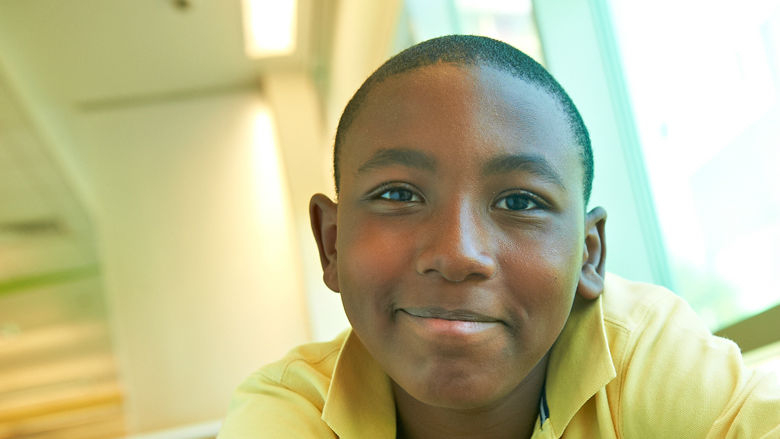Congenital Hyperinsulinism: Lachlan's Story
The Cooper family arrived at Children's Hospital of Philadelphia late on a Wednesday night in June, exhausted after a 35-hour journey from Perth, Australia. "They were expecting us," says Jamie Cooper.
Soon Jamie’s 8-week-old son, Lachlan, was settled in a comfortable room. There the overnight staff worked to stabilize his blood sugar level — hypoglycemia, or low blood sugar, is a dangerous risk of the condition that brought the baby here: congenital hyperinsulinism (HI).
It was the hope of a cure from CHOP’s Congenital Hyperinsulinism Center that had led the Coopers half way around the world — “I don’t think you can get further away,” says Jamie — and it was a combination of cutting-edge technology, comprehensive care and surgical skill that fulfilled that hope.
Three weeks after his middle-of-the-night arrival, Lachlan was cured.
Without the sophisticated level of care he received at Children’s Hospital, the outcome would have been much different.
The diagnosis
Doctors in Australia discovered Lachlan’s low blood sugar when he was only 3 days old. Eventually, he was diagnosed with HI, a condition caused by lesions in the pancreas that disrupt its normal production of insulin. The disease is so rare — about 1 in 50,000 births — it can be difficult for physicians to identify.
Because Lachlan did not respond to drug therapy, the first line of treatment for HI, he would require sophisticated surgery to remove the affected area of the pancreas.
Fortunately, endocrinologists at Perth’s Princess Margaret Children’s Hospital in Australia knew about Children’s Hospital of Philadelphia and the groundbreaking work being done at its Congenital Hyperinsulinism Center.
Under the direction of Charles A. Stanley, MD, the program is one of few in the world that can offer qualified patients a special PET (positron emission tomography) scan under FDA protocols that is the most accurate diagnostic tool for HI. Information gained from the PET scan can mean the difference between a complete cure for HI or not.
“The doctors told us we could go to Paris or Philadelphia,” Jamie says. “But in their opinion, it was Dr. Stanley at CHOP who was the pioneer in HI. It was an easy choice.”
First steps
The Coopers sent an email to CHOP and within two days Jamie and Adrienne were speaking by phone with Dr. Stanley. He described what the family could expect, from tests to potential treatments to care after discharge.
The Coopers then spoke with Ruth Frey, CPNP, then the clinical manager of the Global Patient Services team, who helped them coordinate medical records, acquire necessary documents and make travel plans.
Forty-eight hours later, they were on their way. “It happened so quickly,” Jamie says. “There was no second-guessing.”
Critical answers
Soon after arrival at CHOP, Lachlan was approved for a 18F-DOPA PET scan, the innovative diagnostic tool that would help the medical team determine whether his HI was diffuse (spread throughout the pancreas) or focal (concentrated in one spot).
“All families hope for focal disease,” Adrienne says, because surgeons can remove the distinct lesions of overactive beta cells causing the damage, but leave the rest of the pancreas intact to perform normally, leading to a cure. With diffuse disease, nearly all of the pancreas must be removed with the possible risk of life-long diabetes.
Lachlan’s tests indicated a focal lesion, but were not conclusive. The answer would only be revealed in the operating room. The decision of how much pancreas to remove would be made by Surgeon-in-Chief N. Scott Adzick, MD, who has performed more than 260 pancreatectomies — by far the largest volume of HI surgery in the world.
In the operating room
Surgery started at 4 p.m. on Friday June 25. By 5:20 p.m., Dr. Adzick was already closing the incision. During the procedure, he had felt a tiny lump buried deep in the body of the pancreas. After confirmation by the pathology lab, he removed the 5-millimeter lesion — the miniscule cause of the baby’s condition. Lachlan’s HI had been focal, and he was cured.
“We were so impressed,” Jamie says. “CHOP has the best technology in the world, and it came down to the skill of the surgeon. Dr. Adzick is a big part of the success of this place. At the end of the day, it was the whole process that makes CHOP unique and special.”
The best possible outcome
The Coopers say that the total care the family received at CHOP — from initial contact through their hospital stay — was incomparable. “To be surrounded by so many people who knew so much about HI was comforting,” Adrienne says. “In Australia no one knows much about it.”
Jamie adds: “We came away with an outcome we know could not have been achieved anyplace else in the world.”

